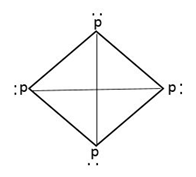
White phosphorus
(This question has multiple correct options)
(A) 6 P-P single bonds
(B) 4 P-P single bonds
(C) 4 lone pair of electrons
(D) P-P-P angle of
Answer
141.9k+ views
Hint: Phosphorus is 15 group elements. Phosphorus is an essential constituent of animal and plant matter. It is present in bones as well as in living cells.
Complete step by step answer:
Phosphorus exists in several allotropic forms.
Example: White phosphorus, red phosphorus, black phosphorus, etc.
White phosphorus is in gaseous state and is a waxy solid consisting of reactive

The structure of phosphorus shows 6 covalent bonds between P-atom and 4 lone pairs of electrons.
Therefore, from the above explanation, the correct option is [A] 6 p-p single bond and [C] 4 lone pair of electrons
Additional information:
White phosphorus is very reactive because
These
The red phosphorus consists of complex chain structure formed by opening of

Black phosphorus has a layered structure and most thermodynamically stable form.
Phosphorus can be considered as light solid.
White phosphorus is very reactive and spontaneously ignites at
Red phosphorus is stable at room temperature but can be converted to white phosphorus by heat, sunlight or friction.
Note: White phosphorus crystallizes in a cubic system. Phosphorus atomic size is more so it can form a single bond with other phosphorus atoms. Hence it exists as tetra atomic molecules.
Complete step by step answer:
Phosphorus exists in several allotropic forms.
Example: White phosphorus, red phosphorus, black phosphorus, etc.
White phosphorus is in gaseous state and is a waxy solid consisting of reactive

The structure of phosphorus shows 6 covalent bonds between P-atom and 4 lone pairs of electrons.
Therefore, from the above explanation, the correct option is [A] 6 p-p single bond and [C] 4 lone pair of electrons
Additional information:
White phosphorus is very reactive because
These
The red phosphorus consists of complex chain structure formed by opening of

Black phosphorus has a layered structure and most thermodynamically stable form.
Phosphorus can be considered as light solid.
White phosphorus is very reactive and spontaneously ignites at
Red phosphorus is stable at room temperature but can be converted to white phosphorus by heat, sunlight or friction.
Note: White phosphorus crystallizes in a cubic system. Phosphorus atomic size is more so it can form a single bond with other phosphorus atoms. Hence it exists as tetra atomic molecules.
Latest Vedantu courses for you
Grade 10 | MAHARASHTRABOARD | SCHOOL | English
Vedantu 10 Maharashtra Pro Lite (2025-26)
School Full course for MAHARASHTRABOARD students
₹33,300 per year
EMI starts from ₹2,775 per month
Recently Updated Pages
Classification of Drugs Based on Pharmacological Effect, Drug Action

Difference Between Alcohol and Phenol

JEE Main Participating Colleges 2024 - A Complete List of Top Colleges

JEE Main Maths Paper Pattern 2025 – Marking, Sections & Tips

Sign up for JEE Main 2025 Live Classes - Vedantu

JEE Main 2025 Helpline Numbers - Center Contact, Phone Number, Address

Trending doubts
JEE Main 2025 Session 2: Application Form (Out), Exam Dates (Released), Eligibility, & More

JEE Main Exam Marking Scheme: Detailed Breakdown of Marks and Negative Marking

JEE Main 2025: Derivation of Equation of Trajectory in Physics

Electric Field Due to Uniformly Charged Ring for JEE Main 2025 - Formula and Derivation

Types of Solutions

Learn About Angle Of Deviation In Prism: JEE Main Physics 2025

Other Pages
NCERT Solutions for Class 12 Chemistry Chapter 6 Haloalkanes and Haloarenes

NCERT Solutions for Class 12 Chemistry Chapter 2 Electrochemistry

NCERT Solutions for Class 12 Chemistry Chapter 7 Alcohol Phenol and Ether

NCERT Solutions for Class 12 Chemistry Chapter 1 Solutions

Solutions Class 12 Notes: CBSE Chemistry Chapter 1

JEE Advanced Marks vs Ranks 2025: Understanding Category-wise Qualifying Marks and Previous Year Cut-offs




